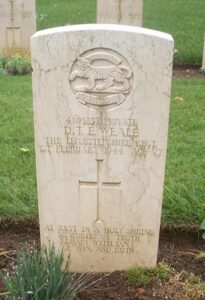Glasbury, or Glasbury-on-Wye, is a village situated on an ancient crossing point on the River Wye, connecting the counties of Breconshire and Radnorshire, and is situated just outside the Brecon Beacons National Park, north of the Black Mountains. The village is split between the communities of Glasbury and Gwernyfed. The nearest town is Hay-on-Wye, some four miles to the north east. Some of the men of the community who fell during both World Wars are commemorated on the main village war memorial which is located on a junction leading to the village green. There are also several other war memorials locally: St. Peter’s Church; All Saints Parish Church; Maesyronen Chapel; and at Treble Hill Baptist Church. The community was unfortunate to have lost three of its bell ringers during the Great War. All are noted below.
The Great War 1914-1918
Charles Arrowsmith, Private, 57054, Welsh Regiment. Charles was the son of George and Eleanor Arrowsmith, of Three Cocks, Brecon. He lived with his elder brother Albert, a farm bailiff, at Courcoed, Bronllys prior to the war. Charles enlisted at Bridgend on 3 November 1915 into the Glamorgan Yeomanry and served at home with the 3rd Battalion, before embarking for France on 4 August 1916, where he was posted to the 14th (Swansea) Battalion, Welsh Regiment. The battalion was attached to 114 Brigade, 38th (Welsh) Division and Charles joined them at Ypres, where the entire division was rebuilding following its efforts during the capture of Mametz Wood in July. The division was by then holding the canal bank sector north of Ypres, and remained there until launching its offensive on the Pilckem Ridge during the opening of the Third Battle of Ypres on 31 July 1917. Following several hard weeks of fighting at Ypres, the division was moved to the Armentieres sector for the winter. At the end of March 1918, the division was moved south and took over the line north of Albert, on the Somme. It remained here until launching an offensive across the flooded Ancre valley on 21 August 1918 and began its drive towards then Hindenburg Line. Charles was killed during the divisions assault on the Masnieres-Beaurevoir line on 8 October 1918, aged 21. He is buried in Bois-Des-Angles British Cemetery, Crevecoeur-Sur-L’escaut, France. (St Peter’s Parish War Memorial)
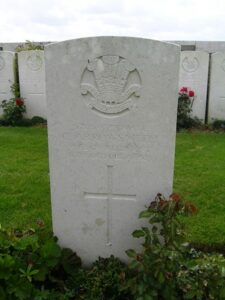
Albert Clayton, Private, 3257, Herefordshire Regiment. Albert was born in 1896, the son of William Clayton and Sarah Clayton (nee Watts), of Old Swan, Glasbury. He enlisted at Hereford into the 1/1st Battalion, Herefordshire Regiment, along with his brother William, soon after the outbreak of war. . The battalion was a Territorial unit and mobilised at Hereford on 4 August 1914, attached to the Welsh Border Brigade, Welsh Division. The Division initially moved to its war station at Pembroke Dock, but soon moved via the Wellingborough area to Bury St. Edmunds, and then to Bedford, where the Division was numbered the 53rd (Welsh) Division. On 19 July 1915 the entire Division sailed from Devonport for Imbros and on 9 August 1915 landed at Suvla Bay. The infantry moved off the beaches into the bush, but due to a lack of maps and no knowledge of the terrain, many of the units became disorientated, and the situation became chaotic. The Division was eventually evacuated from Gallipoli in December 1915, moving to Egypt to join the EEF, and helped guard the Suez Canal before taking part in operations to drive the Turks out of the Sinai. The EEF then turned its attention onto driving the Turks out of Palestine, and on 26 March 1917 launched its first offensive against the coastal city of Gaza, which guarded the road to Jerusalem. Initial gains during the day were lost when the assaulting divisions lost touch with each other and communication broke down when a thick fog cloaked the battlefield. A second attempt to force Gaza was launched on 17 April, which also failed, and the EEF suffered a change in leadership, with Sir Edmund Allenby assuming command, before being re-organised, and a third offensive was launched against a wider front from Beersheba to Gaza on 31 October 1917. This time the Turkish defences were breached, and the road to Jerusalem now lay open and the EEF began to advance north. On 6 November 1917, 158 Brigade launched an attack on the Khuweilfeh Heights. Albert was killed during the assault that day. The 21-year-old has no known grave and is commemorated on the Jerusalem Memorial, Israel. His brother, William, had died in Egypt in January 1917. As far as is presently known, neither man is commemorated locally.

William Clayton, Private, 3256, Herefordshire Regiment. William was born in 1892, the son of William Clayton and Sarah Clayton (nee Watts), of Old Swan, Glasbury. He enlisted at Hereford into the 1/1st Battalion, Herefordshire Regiment, along with his brother Albert, soon after the outbreak of war. . The battalion was a Territorial unit and mobilised at Hereford on 4 August 1914, attached to the Welsh Border Brigade, Welsh Division. The Division initially moved to its war station at Pembroke Dock, but soon moved via the Wellingborough area to Bury St. Edmunds, and then to Bedford, where the Division was numbered the 53rd (Welsh) Division. On 19 July 1915 the entire Division sailed from Devonport for Imbros and on 9 August 1915 landed at Suvla Bay. The infantry moved off the beaches into the bush, but due to a lack of maps and no knowledge of the terrain, many of the units became disorientated, and the situation became chaotic. The Division was eventually evacuated from Gallipoli in December 1915, moving to Egypt to join the EEF, and helped guard the Suez Canal before taking part in operations to drive the Turks out of the Sinai. William was wounded near Romani just after New Year, 1917. He was evacuated to hospital at Kantara where he died of his wounds on 9 January 1917. The 25-year-old is buried in Kantara War Memorial Cemetery, Egypt. His brother, Albert, was killed later that year. As far as is presently known, neither man is commemorated locally.
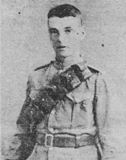
Guy Henry Goad Crosfield, Lieutenant, Rifle Brigade. Guy was the son of Joseph John Crosfield and Alice Lilian Crosfield (nee Stack) of Gwernyfed Park. His father was a wealthy landowner, with property and land in Cheshire and Hampshire. Guy was commissioned into the 5th Battalion, Rifle Brigade and landed in France on 18 July 1916, joining the 1st Battalion, Rifle Brigade, which was attached to 11 Brigade, 4th Division. The division fought throughout the Somme offensive and early in 1917 moved to Arras, to take part in the forthcoming offensive there. The division fought at Ypres later that year before moving back to the Arras area over the winter. Guy was killed near Monchy on 26 January 1918, after volunteering to lead a patrol. The 20-year-old is buried in Monchy British Cemetery, Monchy-Le-Preux, France. (St Peter’s Parish War Memorial)
Reverend Edward Davies, Private, 78821, Royal Army Medical Corps. Edward was the son of the Reverend David Davies and Mrs Elizabeth Davies, of Llanbister. He was educated at Cardiff University before becoming a Baptist Minister at Glasbury and Penyrheol Baptist Churches. Edward married Mary Jane Hamer on 11 July 1906 and the couple lived at Woodville, Glasbury. He enlisted into the Royal Army Medical Corps at Brecon on 29 October 1915 and was posted to France, joining the 150th Field Ambulance, RAMC. Edward was killed during the Battle of Passchendaele, on 23 October 1917, aged 37. He is buried in Bleuet Farm Cemetery, Belgium. (St Peter’s Parish and Treble Hill Baptist Chapel War Memorials)
Frederick James Davies, Private, 1936, Australian Infantry. Frederick was born in Glasbury on 5 July 1881, the son of James and Jane Davies, of Lloynebach. He worked as a collier at Ystradfodwg prior to enlisting into the Royal Navy on 16 April 1901. Frederick spent 12 years in the Royal Navy, and after being discharged migrated to Australia where he found work as a sleeper cutter. He enlisted at Liverpool, NSW into the 3rd Battalion, Australian Infantry on 22 January 1915 and embarked from Sydney, New South Wales, on board HMAT A55 Kyarra on 13 April 1915 with the 5th reinforcements for the battalion. He did not land at Gallipoli with the battalion on 25 April 1915, but joined it on 14 June 1915, with a batch of other reinforcements. Just weeks later Frederick was shot in the chest and taken aboard the Hospital Ship SS Gascon, where he died of wounds on 20 July 1915, aged 35. He was buried at sea, so is commemorated on the Lone Pine Memorial, Gallipoli. (St Peter’s Parish War Memorial)
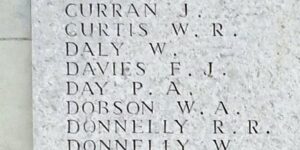
Walter De Winton, Second Lieutenant, Coldstream Guards. Walter was born on 21 February 1893, the son of Major Walter De Winton and Hylda Terese Jane De Winton, of Maesllwch Castle. He was educated at Eton, before passing to Sandhurst and was commissioned into the Coldstream Guards in 1913. On 10 June 1914 his coming of age party was held at Maesllwch, the last time he would be home. Following the outbreak of war, Walter embarked for France with the 3rd Battalion, Coldstream Guards, which was attached to the 4th (Guards) Brigade, 2nd Division, landing at Le Havre on 13 August 1914. The division, one of the first in France, moved to the Belgian frontier and took part in the Battle of Mons from 23 August 1914, before taking part in the epic retreat south to the Marne, where the German offensive was stopped. Walter was killed in action on the opening day of the First Battle of the Marne, on 6 September 1914, when the Allies launched a counter-offensive from the north of the Marne, which stopped the German drive on Paris. He was 21 years old and is buried in Bouilly Cross Roads Military Cemetery, France. (All Saints Parish War Memorial)
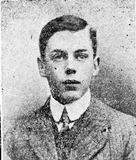
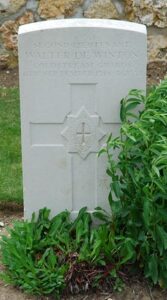
Wilfrid St. Martin Gibbon, Lieutenant, Welsh Regiment. Wilfrid was born in Glasbury on 4 July 1889, the son of Reverend Hugh Harries Gibbon and Esther Gibbon (nee Roberts). His father was from Llawhaden and was widowed when Esther died in 1909. Wilfrid had been educated at Christ College, Brecon before working for the National and Provincial Bank at Cardiff. He enlisted soon after the outbreak of war and was granted a commission into the 2nd Battalion, Welsh Regiment in November 1914. Whilst on leave some months later he married Marjorie Isobel Forester at Formby on 1 May 1915. Wilfrid remained on home service for much of the war until being posted to India. The climate did not agree with him and he suffered three bouts of malaria before dying of enteric fever at Nowshera on 24 April 1918, aged 28. Wilfrid is buried in Nowshera Military Cemetery and is also commemorated on the Delhi Memorial (India Gate). (St Peter’s Parish War Memorial)

Hubert William Douglas Griffith, Lieutenant, Royal Navy. Hubert was born at All Saints Vicarage, Glasbury on 10 June 1887, the son of Reverend Hubert George Griffith and Mrs Marion Griffith. He joined the Royal Navy in 1902 and trained aboard HMS Britannia before going to Exmouth, where he passed as a Midshipman on 15 October 1903. He had several postings over the coming years and by the time of his marriage to Mabel Constance Wrenstead on 28 June 1913 had reached the rank of Lieutenant. His record of service showed him to be an intelligent and capable officer and on 10 November 1916 he was posted aboard the brand-new M-class destroyer HMS Pheasant. Completed in December 1916 she was assigned to the Grand Fleet, joining the 15th Destroyer Flotilla. On the morning of 1 March 1917 Pheasant, together with a number of armed trawlers, was taking part in a routine patrol of the Western entrance to Scapa Flow, when Pheasant struck a German mine, and sank with the loss of 89 lives. Hubert was 29 years old when he was killed that day, and is commemorated on the Plymouth Naval Memorial, Devon. (All Saints Parish War Memorial)
William Austin Hamer, Private 46813, South Wales Borderers. William was the son of John and Sara Hamer, of Old Mill, Llanigon. He worked as a collier in Glynneath prior to enlisting at Neath into the army and was posted to France, joining the 1st Battalion, South Wales Borderers, which was attached to 3 Brigade, 1st Division. He was working at Llawllan Farm in May 1916, so possibly joined the battalion early in 1917 and would then have taken part in the Battle of Arras that spring. Later that year the division took part in the Passchendaele offensive, before moving to the Cambrai sector and taking part in another offensive there. The division was still in the area when the Germans launched their Spring Offensive on 21 March 1918 and took part in desperate fighting before being moved to Flanders to rest. However, on 9 April 1918 the Germans launched a fresh offensive along the Lys valley and the division became caught up in heavy fighting once more. William was taken prisoner by the Germans on 18 April 1918, during the Battle of the Lys. He was taken to a prison camp, where he remained incarcerated until after the Armistice when he was released. Too ill to return home, William was sent to the 42nd Stationary Hospital, Courban, where he died of pneumonia on 4 December 1918, aged 19. William is buried in Charmes Military Cemetery, France. (William was a Bellringer in St. Peter’s Church)
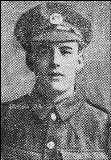
Alfred Reginald Holder, Ordinary Seaman, J/43130, Royal Navy. Alfred was born on 29 March 1896, the son of William and Gwendoline Holder, of Brook Cottage, Glasbury. He worked as a collier prior to enlisting into the Royal Navy on 9 August 1915 and trained at HMS Vivid I before posted to Edinbugh, joining the crew of the battlecruiser HMS Indefatigable. She was serving with the 2nd Battlecruiser Squadron, which was assigned to Vice-Admiral Sir David Beatty’s Battlecruiser Fleet. The fleet had put to sea to intercept the German High Seas Fleet in the North Sea, and came into contact off Jutland. The Germans spotted the British first and made a run to the south to escape, and when Beatty realised this, he ordered his ships to follow. The Germans opened fire first and at around 16.00 on 31 May 1916 a salvo of shells from the German battlecruiser SMS Von der Tann dropped onto Indefatigable, tearing through her armour and setting off a cataclysmic explosion in her magazines, which tore the ship apart. Within seconds 1,016 men had been killed, only three survived. Alfred was just 20 years old when he was killed in the explosion that day, and is commemorated on the Plymouth Naval Memorial, Devon. (All Saints Parish War Memorial)
James Hotchkiss, Private, 13817, King’s Shropshire Light Infantry. James was the son of Richard and Emma Hotchkiss, of Church Stretton, Shropshire. He worked as a coachman at Maesllwch Castle for several years prior to the war, enlisting at Glasbury on 9 September 1914 into the 7th Battalion, King’s Shropshire Light Infantry. The battalion was attached to 76 Brigade, 25th Division and on 28 September 1915 landed at Boulogne. Just over two weeks later the brigade moved to the 3rd Division at Ypres. James saw his first taste of fighting during the actions at Bellewaarde and Hooge, and took part in heavy fighting at the Bluff, and at the St Eloi Craters. The division was then moved south to the Somme, and saw heavy fighting throughout the Somme offensive. By May 1917 the Division was at Arras, and saw heavy fighting there before moving north to Ypres, to take part in the Passchendaele offensive. On 26 September 1917 the 7th KSLI took part in an assault on Polygon Wood, helping gain almost 2,500 yards of ground from the Germans before being relieved after suffering heavy casualties. James had been killed during the attack that day. The 38 years old was buried in Bedford House Cemetery, Belgium. (All Saints Parish War Memorial)
Ernest Hudman, Private, 17455, King’s Shropshire Light Infantry. Ernest was the son of Charles and Annie Hudman, of Hill End, Twyning, Tewksbury. By 1911 the family was living at Westmore, Shetton, Mansell Lacy, Mansell Gamage, and Ernest was working as a gamekeeper at Tregoyd. He enlisted at Hereford into the 1st Battalion, King’s Shropshire Light Infantry, but was among a large number of men from the battalion attached to the 2nd Battalion, Welsh Regiment, following the move of the 1st Division to the Somme. The 2nd Welsh had reached Albert on 10 July before moving forward with the remainder of the division to take part in the Battle of Bazentin Ridge. After four days of fighting the battalion moved back to rest, and then on 26 July took part in another assault, the Battle of Pozieres Ridge, where it saw terrible fighting in Munster Alley alongside the Australians. The division was relieved from the line that night and moved to Millencourt and had several weeks rest before moving into the line again at High Wood and on 8 September attacked the wood in strength. Ernest was killed in action during this attack on 8 September 1916, aged 25. He has no known grave and is commemorated on the Thiepval Memorial, France. (St Peter’s Parish War Memorial)
William Albert James, Pioneer, 341085, Royal Engineers. William was the son of Mary Ann Nicholls, of Groveside, Glasbury. He worked as a Clerk for the Midland Railway prior to the war. He attested into the South Wales Borderers on 12 November 1915 and was mobilised on 12 June 1917, joining the 3rd Battalion at Brecon. He married Ruth Lewis, of Llowes Post Office whilst home on leave on 19 September 1917. On 31 October 1917 he was transferred to the Royal Engineers and was posted to France on Bedford Signal Depot, where he trained as a Signaller. He was posted to France on 1 May 1918 and joined the 34th Division Signal Company, RE. The division was rebuilding in Flanders after its ordeals during the German offensive on the Lys the previous month. From August 1918 the division, now rebuilt, took part in the great advance in Flanders, taking part in the final Battle of Ypres, the Battle of Courtrai and the subsequent Actions of Ooteghem and Tieghem. James became ill towards the end of the war and was hospitalised at 74 General Hospital, Trouville, where he died of influenza on 24 November 1918, aged 28. He was buried in Tourgeville Military Cemetery, France. (St Peter’s Parish War Memorial. William was a Bellringer)
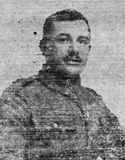
William Edward Jones, Private, 236820, King’s Shropshire Light Infantry. William was the son of Thomas and Jeanette Jones, of Glasbury. He enlisted at Hereford into the Herefordshire Regiment, and was drafted to France in March 1917 to join the 7th Battalion, King’s Shropshire Light Infantry, which was attached to the 3rd Division. By May 1917 the Division was at Arras, taking part in several large-scale offensives during the Battle of Arras before being moved north to Ypres to take part in the Battle of Passchendaele. It saw heavy fighting around Polygon wood before being moved south to the Cambrai sector, in order to take part in the Battle of Cambrai. The division remained in the area over the winter and from 21 March 1918 became caught up in desperate fighting during the German spring offensive, which was launched through thick fog at dawn that day. William was killed near Heninel at some time during the day. He was 22 years old and is commemorated on the Arras Memorial, France. (All Saints Parish War Memorial. William was a Bellringer)
William Rhys Jones, Private, 38589, King’s Shropshire Light Infantry. William was the eldest son of Rhys and Elizabeth Jones, of 4, Pontithel, Three Cocks. He enlisted into the Training Reserve and was posted to France early in 1918, joining the7th Battalion, King’s Shropshire Light Infantry, which was attached to the 3rd Division. He probably joined the battalion after it had been withdrawn from the Somme, after suffering heavy casualties following the German spring offensive. The division moved to Flanders and the 7th KSLI took up a position east of the La Bassée canal, next to the 2nd Welsh. At dawn on 9 April the misfortunate division was hit directly by the Germans second large-scale offensive of the year and suffered severe casualties before being relieved again. The division moved to billets in the Bethune area before again beginning a series of rotation in the front line. By the beginning of June, the 7th KSLI was in trenches near Locon, where it helped advance the line some 3,000 yards. William was wounded here and died of his wounds on 20 June 1918, aged 18. He is buried in Sandpits British Cemetery, Fouquereuil, France. (St Peter’s Parish War Memorial)
Edward Lane, MM, Company Sergeant Major, 77148, Canadian Infantry. Edward was born at Glasbury on 6 August 1877, the son of Edward and Martha Lane. He emigrated to Canada as a young man, along with at least two other siblings, and worked as a smelter man at Vancouver. He had served with the Canadian Militia prior to the outbreak of war, when he enlisted at Victoria, British Columbia into the Canadian Infantry on 11 November 1914. He embarked for Britain with the 30th Battalion, Canadian Infantry aboard the SS Missanabie on 2 February 1915. Upon arrival in England, the battalion became a training unit, and Edward was posted to the 7th Battalion, Canadian Infantry in France on 8 May 1915. The battalion was attached to the 2nd Brigade of the 1st Canadian Division at Ypres, and had been taking part in very heavy fighting during the Second Battle of Ypres, being caught up in the first gas attack of the war at Gravenstafel. Edward took part in the Battle of Festubert with the division soon after joining up with his new battalion, and by 8 August had been promoted to Corporal. By March 1917 he had been promoted Sergeant, and following the epic actions of the Canadians during the Battle of Mount Sorrel in June 1916, gained the award of the Military Medal, before being promoted to Company Sergeant Major. The Canadian Corps moved to the Somme soon after and took part in several actions, namely at Flers-Courcelette, Thiepval, Le Transloy and during the Battle of the Ancre Heights. The following year the Canadians moved to Arras and took part in the Battle of Vimy Ridge in April, breaking the German line on the heights before advancing across the Douai plain a and seeing heavy fighting at the Battle of Arleux. Edward had survived all of these famous actions, but was killed in action at Hill 70 on 15 August 1917, aged 40. He has no known grave and is commemorated on the Vimy Memorial, France. He does not appear to be commemorated on any local war memorial.
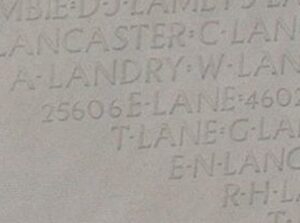
Hugh James Lewis, Sergeant, 355154, Royal Welsh Fusiliers. Hugh was born at Glasbury in 1889, the son of Thomas and Mary Lewis. His parents later lived at Hardwick House, Pembridge, while Hugh lived in Three Cocks, where he worked as a cow man on a farm. He enlisted into the Montgomeryshire Yeomanry at Hay on 9 April 1914 and following the outbreak of war was embodied with the regiment, which moved to Thetford with the South Wales Mounted Brigade, before moving to Cromer in October 1915. On 4 March 1916 the Yeomanry embarked at Devonport and sailed for Egypt, joining the 4th Dismounted Brigade in Western Frontier Force. On 4 March 1917 the Montgomery Yeomanry merged with the 1/1st Welsh Horse at Helmia to form the formed 25th (Montgomery & Welsh Horse Yeomanry) Battalion, Royal Welsh Fusiliers in 231 Brigade, 74th Division. The newly formed division moved into Palestine with the EEF soon after formation and took part in the Second Battle of Gaza from 17 to 19 April 1917. The offensive was a failure and the EEF was reorganised under General Allenby before restarting the offensive to drive the Turks out of Palestine and the 74th Division took part in the Third Battle of Gaza, helping play a part in clearing the country and the capture of Jerusalem. Early in 1918 the division took part in the advance into the Jordan valley and the capture of Jericho. Hugh was wounded during an attack along the Jerusalem to Nablus road, on the Burj Bardawil trenches in March 1918. He died of his wounds on 11 March 1918, aged 28 and was buried on the junction of a wadi on the Nablus road. His grave was later lost and Hugh is commemorated on the Jerusalem Memorial, Israel. (St Peter’s Parish War Memorial)
George Edward Machin, Private, 7411, King’s Shropshire Light Infantry. George was born at Bourne, Lincolnshire in 1874. He married Charlotte Elizabeth Brown at St. Mary’s, Battersea on 30 April 1901 and by 1905 the family had moved to The Shop, Glasbury. George had previously served in the army and was a Special Reservist who had served with the Brecknockshire Battalion, South Wales Borderers prior to the war. He re-enlisted at Glasbury into the King’s Shropshire Light Infantry, and was posted to the 7th Battalion, KSLI, which was attached to 76 Brigade, 25th Division. On 28 September 1915 landed at Boulogne. Just over two weeks later the brigade moved to the 3rd Division at Ypres. James saw his first taste of fighting during the actions at Bellewaarde and Hooge, and took part in heavy fighting at the Bluff, and at the St Eloi Craters. The division was then moved south to the Somme, and saw heavy fighting throughout the Somme offensive. At 3.30 on 14 July 1916 the 7th KSLI took part in an assault against the German line running through the village of Bazentin-le-Petit. The attackers ran into a thick belt of barbed wire, which they could not penetrate, becoming easy targets for German fire. Eight officers and 163 other ranks had been killed during the failed attack that day, plus another seven officers and 294 other ranks wounded. The battalion had been almost annihilated. George was 42 years old when he was killed near Bazentin that day. He has no known grave and is commemorated on the Thiepval Memorial, France. (All Saints Parish War Memorial)
Charles Arthur Gilbert Money, Major, Indian Army. Charles was born on 28 June 1883, the son of Colonel Charles Gilbert Colvin Money and Sophie Louisa Money, of Treble Hill, Glasbury. He was commissioned into the Royal Artillery before transferring to the Indian Army in 1902 and married Madeline Louise Charlotte Willett, of Adderstone, Cleeve Hill, whilst stationed in India. Charles was commanding officer of the 130th King George’s Own Baluchis (Jacob’s Rifles), which was sent to German East Africa at the outbreak of war. Charles died at Kibata, East Africa on 13 December 1916, aged 33. He is buried in Dar es Salaam War Cemetery, Tanzania. (St Peter’s Parish War Memorial)
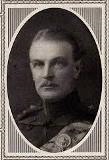
Arthur John Russell Morgan, Private, 88849, Royal Welsh Fusiliers. Arthur was born in 1899, the son of James William Morgan and Jane Elizabeth Morgan (nee Pritchard), of Glasbury Post Office. He enlisted into the Royal Welsh Fusiliers during the summer of 1918. Arthur did not serve overseas, as he had enlisted too late, but became ill and died of disease at Glasbury on 19 April 1919, aged 19. He is buried in St. Peter’s Churchyard, Glasbury. He is not commemorated by the CWGC. (St Peter’s Parish War Memorial)
John Reginald Redvers Price, Seaman, Mercantile Marine. John was born in 1901, the youngest son of George and Elizabeth Price of Velindre. His father was a tailor and innkeeper, running the Three Horse Shoes Inn at Velindre. Reggie attended Velindre School before entering Brecon County Intermediate School in September 1913, continuing there until December 1915 when he left to become a mechanic on the railway. He enlisted into the Mercantile Marine and was posted aboard the steamship SS Glendene. On 4 August 1917 John was aboard Glendene in port at Gravesend, having returned from a voyage from Cuba, on which he had taken ill. He died of typhus aboard the ship that day, aged just 17. His remains were brought home and he was buried in St Peter’s Churchyard, Glasbury. He is not commemorated by the CWGC. (St Peter’s Parish War Memorial)
Reginald Sidney Price, Lance Sergeant, 355162, Royal Welsh Fusiliers. Reginald was the son of Walter and Elizabeth Price, of 19, Hay Road, Velindre. He enlisted into the Montgomeryshire Yeomanry at Hay on 30 April 1914 and following the outbreak of war was embodied with the regiment, which moved to Thetford with the South Wales Mounted Brigade, before moving to Cromer in October 1915. On 4 March 1916 the Yeomanry embarked at Devonport and sailed for Egypt, joining the 4th Dismounted Brigade in Western Frontier Force. On 4 March 1917 the Montgomery Yeomanry merged with the 1/1st Welsh Horse at Helmia to form the formed 25th (Montgomery & Welsh Horse Yeomanry) Battalion, Royal Welsh Fusiliers in 231 Brigade, 74th Division. The newly formed division moved into Palestine with the EEF soon after formation and took part in the Second Battle of Gaza from 17 to 19 April 1917. The offensive was a failure and the EEF was reorganised under General Allenby before restarting the offensive to drive the Turks out of Palestine. On 31 October 1917 the 74th Division took part in an assault on the Turkish held positions around Beersheba. Reginald was killed in action that day. He was 22 years old and is buried in Beersheba War Cemetery, Israel. (St Peter’s Parish War Memorial)
John Pugh, Sapper, 323536, Royal Engineers. John was born in Glasbury. He began working for the Great Western Railway at the age of 14 and moved to Machen to work as a shunter prior to the war. He married Amy Maria Baker at Bassaleg on 11 March 1891 and the couple lived in The Gables, Wyndham Street, Machen. John enlisted at Caerphilly into the 19th Battalion, Welsh Regiment on 5 April 1915. The battalion was the Pioneer battalion to the 38th (Welsh) Division and John landed in France with the battalion on 5 December 1915. He served in France for five months before being transferred home, probably due to his age, and was transferred to the 23rd Works Battalion, King’s Liverpool Regiment. On 30 June 1917 he transferred to the Royal Engineers, and was drafted to the Middle East to join the 96th Light Railway Operating Company, sailing aboard the troopship SS Aragon from Marseilles to Alexandria. On 30 December 1917 Aragon was about eight miles off Alexandria when she was torpedoed by the German submarine UC-34 and began to sink. Although a large number of troops, sailor and nurses were rescued, around 610 people lost their lives that day. John was 44 years old when he drowned that day. His body was later recovered from the sea and he was buried in Alexandria (Hadra) War Memorial Cemetery, Egypt. (St Peter’s Parish War Memorial)
Frederick John Wackett, Private, 17920, King’s Shropshire Light Infantry. Frederick was born at Chirk in 1897, the son of Walter and Julia Wackett. His father was a Groom at Chirk Castle and prior to the war had moved to Maesllwch Lodge, Glasbury, to work at Maesllwch Castle. Frederick enlisted at Hereford into the 5th Battalion, King’s Shropshire Light Infantry. The battalion was attached to 42 Brigade, 14th Division and had landed in France on 20 May 1915. Frederick joined the battalion as a draft at Ypres on 5 October 1915, following its ordeals during the Action of Hooge, where the Division was the first to be attacked by the German use of flamethrowers. In July 1916 the division moved to the Somme, and took part in heavy fighting at Delville Wood and at Flers-Courcelette, during an attack which was to see the first ever use of tanks in action. Frederick was killed during the second day of the battle, on 16 September 1916, aged 19. He has no known grave and is commemorated on the Thiepval Memorial, France. (All Saints Parish War Memorial)
David Percy Whittall, Corporal, 53720, Welsh Regiment. David was born on 19 December 1894, the son of John and Edith Whittall, of Grove Side, Glasbury. He worked as a postman at Llowes prior to gaining an apprentice engineering role at Abergavenny. David enlisted at Abergavenny into the 3rd Battalion, Monmouthshire Regiment, and landed in France on 13 February 1915. He was wounded later in the year and returned home to recuperate, before being drafted back out to France in May 1916 and joined the 9th Battalion, Welsh Regiment, which was attached to 58 Brigade, 19th Division. The division had moved from the Loos sector by then, and on 1 July 1916 took part in the opening assault of the Somme offensive, attacking from the direction of Albert towards La Boisselle. The division saw heavy fighting on the Somme during the coming months, and by November 1916 was in positions around Leipzig Redoubt. David was killed in action near the Redoubt on 5 November 1916, aged 21. He has no known grave and is commemorated on the Thiepval Memorial, France. (St Peter’s Parish War Memorial)
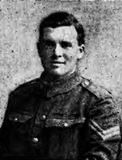
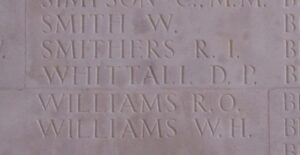
Thomas Williams, Private, 18464, South Wales Borderers. Thomas was the son of Edwin and Elizabeth Williams, of Cwmdu, Glasbury. He worked as a labourer at Abercynon prior to enlisting at Brecon into the 2nd Battalion, South Wales Borderers. The battalion had returned to England after service in China on 12 January 1915, joining 87 Brigade, 29th Division. Thomas then embarked with the battalion at Avonmouth on 17 March 1915. The division had been despatched to Egypt prior to taking part in the forthcoming landings on Gallipoli and on 25 April 1915 landed at Suvla Bay, under heavy Turkish fire. Thomas survived the arduous Gallipoli campaign and was evacuated from the Peninsula with the battalion on 11 January 1916, when the division moved to Egypt. On 15 March 1916 the division arrived in Marseilles and entrained for northern France, and the Somme sector. On 1 July 1916 the 2nd SWB launched an attack across open ground towards the strongly defended German position at Y-Ravine, Beaumont Hamel, but suffered terrible casualties. On 24 July the battered 29th Division was relieved and moved to the Ypres salient to rebuild. Thomas was unfortunately killed on 2 October 1916, during the divisions last few days in the Ypres trenches before returning to the Somme. He was 24 years old and was buried in Vlamertinghe Military Cemetery, Belgium. Four days later the battalion left Ypres and entrained for the Somme. (All Saints Parish War Memorial)
World War Two, 1939-1945
John Thomas Davies, Leading Seaman, JX760181, Royal Navy. John was born at Glasbury on 23 December 1928, and lived at Box Cottages, Three Cocks. He enlisted into the Royal Navy and served aboard the destroyer HMS Battleaxe, which had been launched just after the end of WW2. John was one of two men who drowned after falling overboard from Battleaxe on 6 July 1952. John was 23 years old. Nothing else is currently known of him. (St Peter’s Parish War Memorial)
Kenneth George Charles Davies, Flying Officer, 44522, Royal Air Force. Kenneth was the son of George Davies and Alice Davies (nee Stephens), of Llowes Court, Llowes. He enlisted into the Royal Air Force and trained as a pilot, marrying Joyce Betty Mayall in 1941, before being posted to 208 Squadron, RAF, which was stationed in Egypt, flying Hurricanes in support of the Eighth Army. On 9 February 1942 Kenneth was flying Hurricane I, Serial V7836 when the aircraft was lost in the desert. Kenneth was 23 years old when he died that day and is commemorated on the Alamein Memorial, Egypt.
Reginald Arthur Gittoes, Private, 4032351, King’s Shropshire Light Infantry. Reginald was the son of John and Mary Ann Gittoes, of Little Mill Cottage, Llowes. He lived at 15, Laburnam Grove, Hereford prior to enlisting into the King’s Shropshire Light Infantry and was posted to the 2nd Battalion, KSLI, which was attached to the 3rd Division. The battalion landed on Sword Beach, Normandy on D-Day, 6 June 1944, where it was counter-attacked by the German 21st SS Panzer Division. During the coming weeks the 3rd Division took part in the fighting to break out from the beach-head, fighting during the Battle for Caen and in the Falaise pocket. Reginald was killed during Operation Epsom, an operation intended to take the high ground west of Caen, on 27 June 1944, aged 26. He is buried in Ranville War Cemetery, France. (All Saints Parish War Memorial)
Wilfred John Lewis, Private, 5728773, Dorsetshire Regiment. Wilfred was the son of Alfred John Lewis and Betha Lewis (nee Price), of Upper Cockett, Hay. He married Myfanwy Edwina Davies, of Hay, in 1939. Wilfred enlisted into the army following the outbreak of war and was posted to the 2nd Battalion, Dorsetshire Regiment. The battalion was in France with the BEF and was evacuated from Dunkirk after suffering heavy casualties. It then spent nearly two years guarding the Yorkshire coast against invasion, before being sent to India in 1942. Wilfred became ill during the voyage and died at Cape Town, South Africa on 21 May 1942, aged 22. He is buried in Maitland Cemetery, Cape Town. (St Peter’s Parish War Memorial)
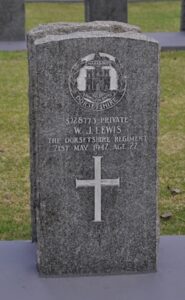
Albert Llewellyn Thomas Meale, Private, 7958120, Welch Regiment. Albert was the son of Albert Wilfred Meale and Annie Sarah Meale (nee Pritchard), of Glasbury. He enlisted into the army and was posted to the 1st Battalion, Welch Regiment. The battalion had a torrid war. It was stationed in Palestine at the outbreak of war, attempting to keep the peace between the Arabs and the Jews, before moving to Mersa Matruh, Egypt in November 1939. Whilst waiting to take part in the offensive against the Italians in North Africa, the 1st Welch was assigned to CREFORCE on 18 February 1941 and despatched to Crete. On 14 May 1941 600 German aircraft bombed the island before elite German paratroopers began landing on 20 May. The 1st Welch, at Suda Bay, fought gallantly over the coming days but the battalion was virtually wiped out, only some 170 survivors reaching Alexandria after being evacuated by the Royal Navy. In September a draft of 700 officers and men arrived to rebuild the shattered battalion, which then became caught up in the fighting around Benghazi, where it became surrounded and the survivors, some 200 men, made an epic march of some 200 miles through hostile territory to reach safety. The battalions next major actions took place during the invasion of Sicily and mainland Italy. Albert was killed during an assault on the village of Casa Menghino, near Croce, on 9 September 1944, aged 21. He is commemorated on the Cassino Memorial, Italy. (All Saints Parish War Memorial)
Robert Cotton Money, Second Lieutenant, 85631, Cameronians (Scottish Rifles). Robert was the son of Major-General Robert Cotton Money, CB, MC and Daphne Darina Flora Money (nee Gartside-Spaight), of Glasbury. His father had commanded the 15th (Scottish) Division during the Great War. Robert followed in his fathers footsteps and was commissioned into the 2nd Battalion, Cameronians (Scottish Rifles). The battalion was based at Catterick when war erupted and was sent to France to join the BEF, taking part in heavy fighting during the withdrawal to Dunkirk. Robert was killed in action whilst attempting to rescue a fellow officer, on the old WW1 battlefields of Wytschaete, Belgium, on 27 May 1940, aged 21. He is buried in Oostaverne Wood Military Cemetery, Belgium. (All Saints Parish War Memorial)
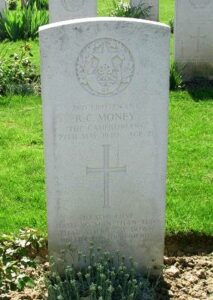
Arthur Samuel Price, Lance Corporal, 2735481, Welsh Guards. Arthur was born in Glasbury in 1919, the son of Thomas James Price and Annie Price. He married Enid Dorothy Veale, of Knowle, Bristol, in 1943. Arthur had enlisted into the 1st Battalion, Welsh Guards. The battalion had seen heavy fighting in France in 1940, and spent the next four years on home service. In June 1944 the 1st Welsh Guards returned to France, attached to the Guards Armoured Brigade, and spent most of the month in positions near Cheux. From 17 July the Guards Armoured Division took part in a large operation to break out of Normandy, fighting around Caen. Arthur was killed in Normandy on 12 August 1944, aged 25. He is buried in Banneville-La-Campagne War Cemetery, France. (All Saints Parish War Memorial)
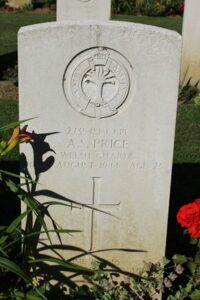
Vincent Leslie Stephens, Sergeant, 1119436, Royal Air Force Volunteer Reserve. Vincent was the son of William Stephens and Ellen Stephens (nee Driscoll), of Tyla Glas Farm, Three Cocks. He enlisted into the Royal Air Force Volunteer Reserve and trained as a pilot before being posted to 214 Squadron, RAF, which was based at Stradishall. On the night of 1 April 1942 Vincent took off from Stradishall as co-pilot of Wellington Ic, Serial Z8842, as part of a large force despatched to bomb railway infrastructure around Hanau. His aircraft reached the target, but was brought down by flak and crashed off the Dutch coast on the following morning, 2 April 1942, with the loss of all six men aboard. The mission saw very high losses, after 34% of the Wellingtons failed to return. Only the bodies of Vincent and Sergeant Walker were recovered from the sea. Vincent was 21 years old when he died that morning and is buried in Flushing (Vlissingen) Northern Cemetery, Netherlands. (St Peter’s Parish War Memorial)
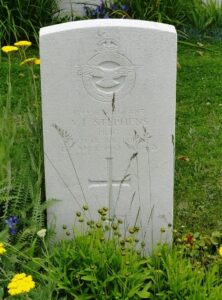
Mary Winifred Annie Weale, Volunteer, W/36660, Auxiliary Territorial Service. Mary was born on 17 December 1920, the daughter of Ezra Weale, and Florence Weale (nee Jones), of Summer Court Cottage, Lyonshall. She was living and working as a hospital cook at Painscastle in 1939, before volunteering to serve in the Auxiliary Territorial Service. Mary died on 21 August 1940, aged just 19. She is buried in St. Peter’s Churchyard, Glasbury. Her brother, David, was killed in Italy on 1 February 1944. (Not commemorated in Glasbury)
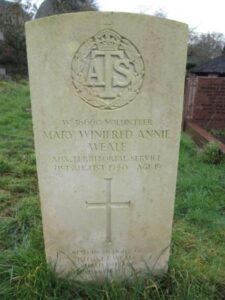
David Thomas Ezra Weale, Private, 4105552, Leicestershire Regiment. David was the son of Ezra Weale, and Florence Weale (nee Jones), of Summer Court Cottage, Lyonshall. He married Catherine Winifred Perks in Glasbury in 1940 and the couple had a daughter, Ruth. David enlisted into the army and was posted to the 2/5th Battalion, Leicestershire Regiment. The battalion had been in France with the BEF in 1940 and after evacuation spent two and a half years in England. In January 1943 the battalion took part in Operation Torch, as part of the 1st Army’s landings in North Africa and saw heavy casualties at Kasserine. The Battalion next saw action at Salerno in Italy, followed by actions at the crossing of the Volturna and Teano Rivers, and at Mount Camino. David was killed in Italy on 1 February 1944, aged 27. He is buried in Cassino War Cemetery, Italy. His sister had died in 1940 whilst serving with the ATS. (Not commemorated in Glasbury, but is commemorated on his sisters headstone)
